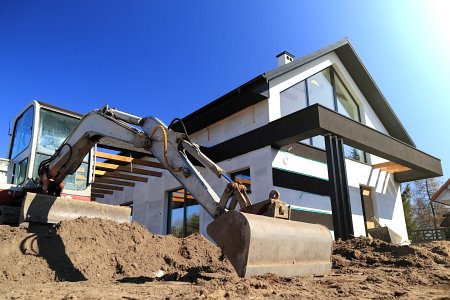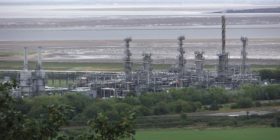How much does it cost to build a house in the UK in 2025?

Everyone dreams of having their own flat or house. Even a small but personal space gives a lot of satisfaction and joy. It makes us relax more effectively and feel better. In recent years, we have seen a dynamic increase in the price of real estate – land and houses as well as building materials.
High inflation has also pushed up the prices of renovation and construction services. All this has meant that the cost of building a house has risen dramatically in 2023 and 2024. Even though the price increases have slowed down somewhat, it is still very expensive to build a house from scratch. In this article, we will show you how the cost of building a house is shaping up in the current year – 2025. We invite you to read on.
What are the average costs of building a house in the UK in 2025?
Shell and core stage
Constructing a house to the shell and core stage is a crucial phase in any building project. This stage means the building is externally complete but requires internal finishes. As of 2025, the average cost to build a house to this stage in the UK is approximately £1,900 per square metre. For a 120 m² house, the total cost would be around £228,000. This estimate includes expenses for building materials, labour, and internal installations such as electricity, plumbing, and heating systems.
The rise in material costs over recent years has impacted overall construction expenses. It’s important to note regional price variations across the country, which can be as much as 15%. For example, building costs in London and the South East may be higher than in the North of England or Scotland.

Weatherproof shell stage
Building a house to the weatherproof shell stage is less expensive than completing it to the shell and core stage, as it involves fewer advanced works. This stage implies that the building has walls, a roof, windows, and doors but lacks internal finishes and installations. The cost to build a house to the weatherproof shell stage ranges from £1,500 to £1,700 per square metre, depending on the region.
For a house measuring 120 m², the total cost would range from £180,000 to £204,000. It’s crucial to include expenses for groundwork, foundations, and roof structure, which can vary based on soil conditions and local climate.
Finishing costs
Interior finishing is another essential phase that affects the final appearance and functionality of the house. The additional cost for interior finishes averages between £450 and £650 per square metre. This includes tasks such as:
- Installing flooring (laminate, hardwood, tiles)
- Painting walls and ceilings
- Fitting internal doors
- Equipping bathrooms and kitchens (sanitary ware, fixtures)
- Installing lighting
For a house with a floor area of 120 m², the finishing costs would amount to between £54,000 and £78,000. Remember that these costs can vary depending on the chosen standard of finish and materials used. Opting for more affordable yet durable materials can significantly reduce expenses, but it’s advisable not to compromise on quality to avoid future repair and renovation costs.
Summary – how much does it cost to build a house in 2025?
The cost of building a house in 2025 depends on various factors, including the stage of completion, location, and choice of materials. The shell and core stage costs approximately £1,900 per m², the weatherproof shell stage ranges from £1,500 to £1,700 per m², and interior finishing adds an additional £450 to £650 per m². Before commencing construction, it’s essential to thoroughly analyse all aspects and prepare a detailed budget to avoid unforeseen expenses and ensure a smooth investment process.

Factors influencing the cost of building a house
Location
Location is one of the most significant factors affecting construction costs. Prices can vary considerably depending on the region within the UK. For instance, building costs in London and the South East are higher than in the North or rural areas. These differences arise from several aspects:
- Availability of building materials. In regions with well-developed infrastructure and a higher number of suppliers, building materials may be cheaper due to competition. In less developed areas, transportation of materials can increase costs.
- Cost of building plots. In major cities and their surroundings, such as London, the price of building plots is significantly higher than in rural areas. The cost of a building plot in the South East can be several times higher than in regions like Wales or Northern Ireland.
- Labour costs. In regions with a higher cost of living, rates for building services are higher due to increased wages and living expenses for workers.
Size of the house
The cost of building smaller houses is higher per square metre compared to larger buildings. This is due to several reasons:
- Fixed costs. Certain expenses, such as design fees, obtaining permits, or site preparation, are independent of the building’s size. In smaller houses, these costs are spread over a smaller area, increasing the cost per square metre.
- Economy of scale. Larger buildings can benefit from economies of scale, meaning that certain materials and services can be cheaper per unit when purchased in larger quantities.
- Proportions. Larger houses often have more favourable ratios of floor area to perimeter, reducing the relative costs of external elements like walls and roofs.
Building materials
Prices of building materials have significantly increased in recent years but are currently stabilising. Nonetheless, price differences depending on the type of materials remain substantial:
- Type of materials. Materials such as concrete, steel, timber, or insulation can have varying prices depending on their quality and specifications. High-quality materials offering better insulation or durability are generally more expensive.
- Local markets. Depending on the region, the availability and popularity of certain materials can affect their prices. For example, timber may be cheaper in areas with a developed timber industry.
- Market price fluctuations. Global events, such as economic crises or conflicts, can influence building material prices. For instance, the cost of imported materials may rise due to exchange rate fluctuations.
Labour costs
The rise in prices for building services significantly impacts the total cost of constructing a house. Several factors affect these costs:
- Supply and demand. In regions with high demand for building services, such as major cities, labour costs are higher. A shortage of skilled workers also leads to increased prices.
- Wages. Rising living costs and wages for construction workers directly affect service costs. For example, in regions with higher salaries, such as London, labour rates are higher than in less affluent areas.
- Specialist services. The cost of specialist services, such as electrical installations, plumbing, or finishing works, also impacts the total construction cost. These services require skilled personnel, which further increases expenses.

Example costs in different scenarios
Single-storey house 100 m²
Building a single-storey house with a floor area of 100 m² to the weatherproof shell stage would cost approximately £160,000. This stage includes erecting walls, constructing the roof, and installing windows and external doors. The house is secured against weather but requires interior finishing.
The cost of finishing a single-storey house is around £55,000. This covers internal installations like electrical, plumbing, heating systems, as well as finishing works such as painting, flooring, and fitting bathrooms and kitchens. The total cost of building such a house, including the weatherproof shell and finishing, amounts to approximately £215,000.
Two-storey house 120 m²
Building a two-storey house with a floor area of 120 m² to the weatherproof shell stage costs around £192,000. A two-storey house often requires more advanced construction work, affecting cost increases. This stage includes foundations, load-bearing walls, roof, and window and door installations.
The interior finishing costs for such a house are about £66,000. Finishing includes electrical and plumbing installations, staircase installation, flooring, wall finishes, and full equipping of bathrooms and kitchens. Therefore, the total cost of building a two-storey house is approximately £258,000.
House over 150 m²
Building larger houses, with floor areas exceeding 150 m², involves proportionally higher costs but offers some savings due to economies of scale. The cost of constructing the weatherproof shell for a 150 m² house averages £240,000. In houses of this size, more advanced construction and installation solutions are applied, influencing the final cost.
The interior finishing costs for a house over 150 m² are about £82,500. This includes a wide range of works, from internal installations to complete room finishes. In larger houses, these costs may be lower per square metre due to economies of scale.
House over 200 m²
Building a house with a floor area exceeding 200 m² entails even higher costs for both the weatherproof shell and finishing works. The cost of constructing the weatherproof shell for such a house can be around £320,000, depending on the materials and building technologies used.
The interior finishing costs for a 200 m² house are approximately £110,000. This expenditure includes full finishing of all rooms, sanitary, electrical, and heating installations, as well as additional features like smart home systems, which are increasingly popular.
Estimated costs of building a house in 2025 in UK
The costs of building a house in 2025 vary depending on the building’s size, scope of work, and materials used. A single-storey house of 100 m² costs approximately £215,000, a two-storey house of 120 m² around £258,000, and houses over 150 m² and 200 m² approximately £322,500 and £430,000 respectively. Before starting the investment, it’s advisable to thoroughly analyse all costs and prepare a detailed budget to avoid unforeseen expenses and ensure financial fluidity for the project.
Future cost projections
Expected stabilisation
In the coming years, a stabilisation of building material prices is anticipated, which may positively impact the overall costs of constructing houses. After a period of dynamic price increases resulting from global economic upheavals, such as the COVID-19 pandemic and geopolitical conflicts, the building materials market is beginning to stabilise. Experts forecast that prices will remain at current levels with slight fluctuations, allowing investors to better plan their budgets.
With price stabilisation, investors can expect less risk of sudden increases in material costs. This enables more predictable and stable investment planning, which is particularly important in long-term construction projects.
Impact of inflation
Inflation directly affects the costs of building houses. In the coming years, construction costs are expected to rise at a rate similar to inflation, around 3%-4% annually. Inflation influences the increase in prices of building materials, services, and wages for construction workers.
To minimise the impact of inflation on the construction budget, it’s worth considering potential price increases during the planning stage. How can you protect yourself against the effects of inflation?
- Fixed-price contracts. Entering into contracts with suppliers and service providers with guaranteed fixed prices for a specified period helps avoid unexpected expenses and stabilises investment costs.
- Early procurement. Purchasing materials early, when prices are lower, can reduce the impact of future price increases.

Advice for those building a house in 2025 in UK
Negotiating material prices
Effective negotiation of building material prices is crucial in managing construction costs. Price differences can be significant depending on the supplier and region. Here are some tips:
- Compare Offers. Always compare quotes from different suppliers to find the best prices and terms.
- Bulk Purchases. Buying materials in larger quantities often leads to better prices. Coordinating purchases with other builders or projects can be beneficial.
- Seasonal Promotions. Take advantage of seasonal discounts and promotions. Material prices can be lower during off-peak periods.
Budget planning
Careful budget planning is essential for the success of any construction project. Include all potential costs to avoid financial surprises. Steps to plan your construction budget:
- Detailed cost estimate. Prepare a comprehensive cost estimate covering all stages, from groundwork to finishing touches.
- Contingency fund. Allocate a contingency fund of about 10%-15% of the total budget for unforeseen expenses.
- Additional costs. Remember to include costs such as land purchase, planning permissions, surveys, and interior decoration.
Building a house is a significant investment influenced by various factors, including material costs, labour, location, and economic conditions like inflation. By staying informed and planning carefully, you can manage your budget effectively and bring your dream home to life in 2025.
Summary – how much does it cost to build a home in the UK in 2025?
Dreams of owning our own home are close to most of us. We want to live in large, comfortable spaces preferably with a backyard. Unfortunately, year after year, the cost of building the house of our dreams increases at a very fast pace. Depending on the location and the price of the land, the total cost of building a house can vary greatly. In this article, we have given you an idea of the approximate costs you have to face when planning such an investment. We hope that we have helped you find the answer to the title question, i.e. how much does it cost to build a house in the UK in 2025?
For more information on construction and current trends in the industry, visit https://www.cpcs-training-courses.co.uk/
Spotted something? Got a story? Send a Facebook Message | A direct message on Twitter | Email: [email protected] Latest News









